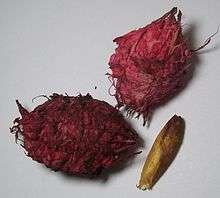Terminalia catappa
| Terminalia catappa | |
|---|---|
.jpg) | |
| Scientific classification | |
| Kingdom: | Plantae |
| Clade: | Angiosperms |
| Clade: | Eudicots |
| Clade: | Rosids |
| Order: | Myrtales |
| Family: | Combretaceae |
| Genus: | Terminalia |
| Species: | T. catappa |
| Binomial name | |
| Terminalia catappa | |
| Synonyms[1] | |
|
List
| |
Terminalia catappa is a large tropical tree in the leadwood tree family, Combretaceae, that grows mainly in the tropical regions of Asia, Africa, and Australia.[2] It is known by the English common names country-almond, Indian-almond, Malabar-almond, sea-almond, tropical-almond[3] and false kamani.[4]
Description
_leaves_before_falling_in_Kolkata_W_IMG_3245.jpg)
The tree grows to 35 m (115 ft) tall, with an upright, symmetrical crown and horizontal branches. Terminalia catappa has corky, light fruit that are dispersed by water. The seed within the fruit is edible when fully ripe, tasting almost like almond. As the tree gets older, its crown becomes more flattened to form a spreading, vase shape. Its branches are distinctively arranged in tiers. The leaves are large, 15–25 cm (5.9–9.8 in) long and 10–14 cm (3.9–5.5 in) broad, ovoid, glossy dark green, and leathery. They are dry-season deciduous; before falling, they turn pinkish-reddish or yellow-brown, due to pigments such as violaxanthin, lutein, and zeaxanthin.
_tree_in_Kolkata_W_IMG_2207.jpg)
The trees are monoecious, with distinct male and female flowers on the same tree. Both are 1 cm (0.39 in) in diameter, white to greenish, inconspicuous with no petals; they are produced on axillary or terminal spikes. The fruit is a drupe 5–7 cm (2.0–2.8 in) long and 3–5.5 cm (1.2–2.2 in) broad, green at first, then yellow and finally red when ripe, containing a single seed.
The species epithet is based on the Malay name Ketapang.[5][6]
Habitat and range
The tree has been spread widely by humans, so the native range is uncertain. It has long been naturalised in a broad belt extending from Africa to northern Australia and New Guinea through Southeast Asia and Micronesia into the Indian Subcontinent. More recently, the plant has been introduced to parts of the Americas. Until the mid-20th century, the tree had been used extensively in Brazilian urban landscaping, since being a rare case tropical deciduous, their fallen leaves would give a "European" flair to the street. This practice is currently abolished, and the "amendoeiras" are being replaced by native, evergreen trees.
Cultivation and uses

T. catappa is widely grown in tropical regions of the world as an ornamental tree, grown for the deep shade its large leaves provide. The fruit is edible, tasting slightly acidic.
The wood is red and solid, and has high water resistance; it has been used in Polynesia for making canoes. In Tamil, almond is known as nattuvadumai.
The leaves contain several flavonoids (such as kaempferol or quercetin), several tannins (such as punicalin, punicalagin or tercatin), saponines and phytosterols. Due to this chemical richness, the leaves (and the bark) are used in different herbal medicines for various purposes. For instance in Taiwan, fallen leaves are used as an herb to treat liver diseases. In Suriname, an herbal tea made from the leaves has been prescribed against dysentery and diarrhea. The leaves may contain agents for prevention of cancers (although they have no demonstrated anticarcinogenic properties) and antioxidants, as well as anticlastogenic characteristics. Extracts of T. catappa have shown activity against Plasmodium falciparum chloroquine (CQ)-resistant (FcB1) and CQ-sensitive (HB3) strains.[7]
Keeping the leaves in an aquarium may lower the pH and heavy-metal content of the water. It has been used in this way by fish breeders for many years, and is active against some parasites and bacterial pathogens.[8] It is also believed to help prevent fungus forming on the eggs of the fish.
Gallery
 Foliage and fruit
Foliage and fruit_in_Hyderabad%2C_AP_W_IMG_0495.jpg) Inflorescence
Inflorescence_branches_with_new_leaves_%26_flower_spikes_in_Kolkata_W_IMG_3260.jpg) Branches with new leaves and flower spikes in Kolkata
Branches with new leaves and flower spikes in Kolkata_trunk_in_Kolkata_W_IMG_2214.jpg)
_old_trunk_in_Kolkata_W_IMG_2218.jpg) Old trunk in Kolkata
Old trunk in Kolkata_fallen_leaf_in_Kolkata_W_IMG_2217.jpg) Fallen leaf in Kolkata
Fallen leaf in Kolkata_fallen_leaf_(back_side)_in_Kolkata_W_IMG_2220.jpg) Fallen leaf (back side) in Kolkata
Fallen leaf (back side) in Kolkata Fallen leaves from Singapore
Fallen leaves from Singapore Green leaves from Singapore
Green leaves from Singapore Trees from Singapore
Trees from Singapore Terminalia catappa - MHNT
Terminalia catappa - MHNT
| Wikimedia Commons has media related to Terminalia catappa. |
References
- ↑ "The Plant List: A Working List of All Plant Species".
- ↑ Pankaj Oudhia, Robert E. Paull. "West Indian Almond Terminalia catappa L. Combretaceae" p. 273-276. Encyclopedia of Fruit and Nuts. 2008, J. Janick and R. E. Paull, editors. CABI, Wallingford, United Kingdom.
- ↑ "Terminalia catappa L." Germplasm Resources Information Network (GRIN). Agricultural Research Service (ARS), United States Department of Agriculture (USDA). Retrieved 3 July 2016.
- ↑ A.K. Kepler. Trees of Hawaii.
- ↑ Stuhlmann, Franz (1909). Deutsch Ost Afrika. Band X. Beitrage zu Naturgeschichte von Ostafrika. Berlin: Dietrich Reimer. p. 122.
- ↑ Hynnersley, C.W.S. (1913). Noctes orientales. Being a selection of essays read before the Straits Philosophical Society between years 1893 and 1910 (Criticism). Singapore. Kelly and Walsh. p. 183.
- ↑ Hnawia E, Hassani L, Deharo E, Maurel S, Waikedre J, Cabalion P, Bourdy G, Valentin A, Jullian V, Fogliani B. "Antiplasmodial activity of New Caledonia and Vanuatu traditional medicines". Pharm Biol. 2011 Apr; 49(4): 369-76.
- ↑ C. Chitmanat; K. Tongdonmuan; P. Khanom; P. Pachontis & W. Nunsong (2005). "Antiparasitic, antibacterial, and antifungal activities derived from a Terminalia catappa solution against some Tilapia (Oreochromis niloticus) pathogens". Acta Horticulturae. pp. 179–182.
External links
- Indian almond leaves and their use in aquariums
- Indian almond leaves- Website devoted to Indian almond leaves in folk medicine, modern medicine and aquariums
- More Ketapang Info- Blog on ketapang leaves
- Daun Ketapang- Daun Ketapang
- Indian Almond Leaves- Indian Almond Leaves